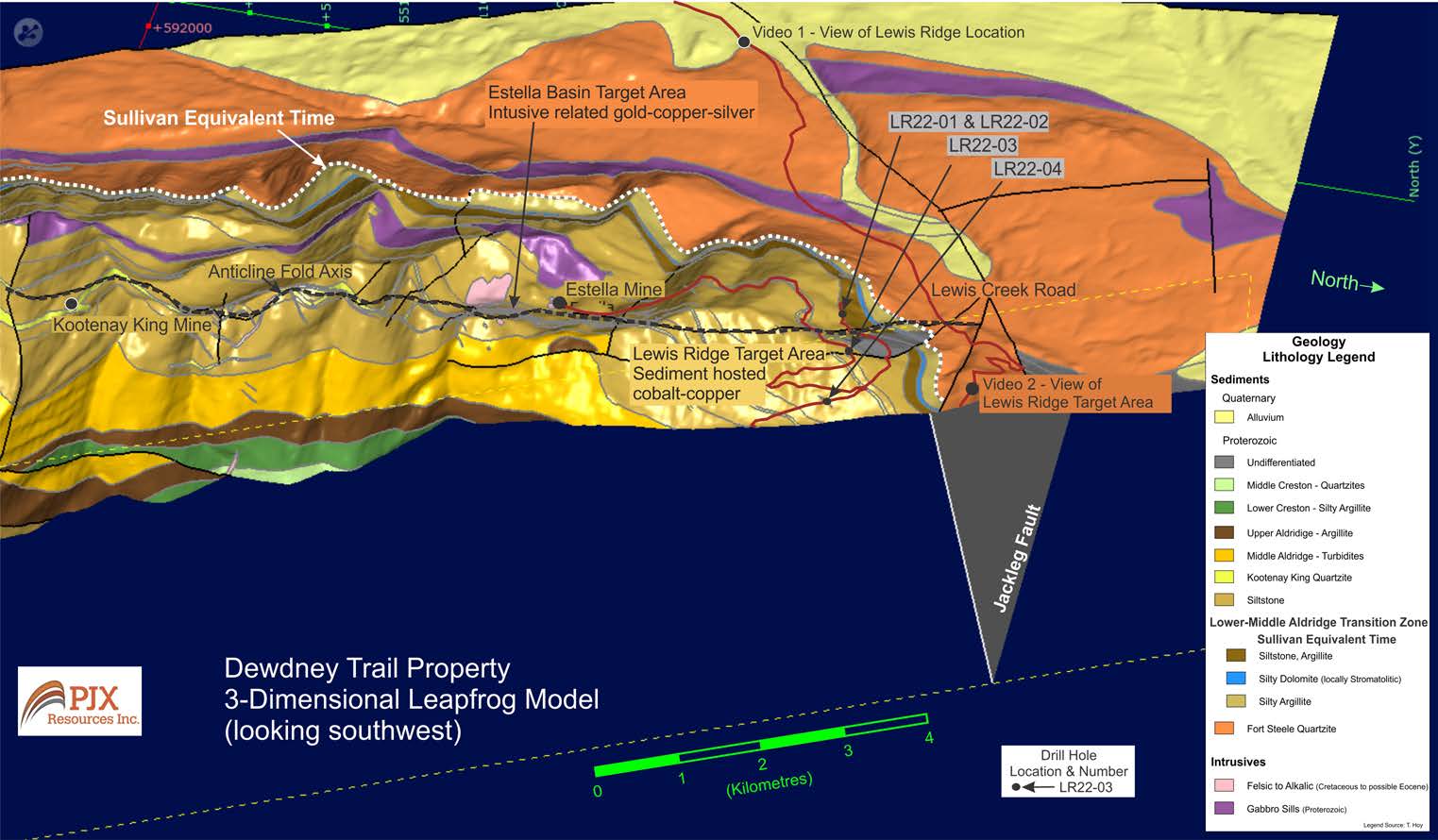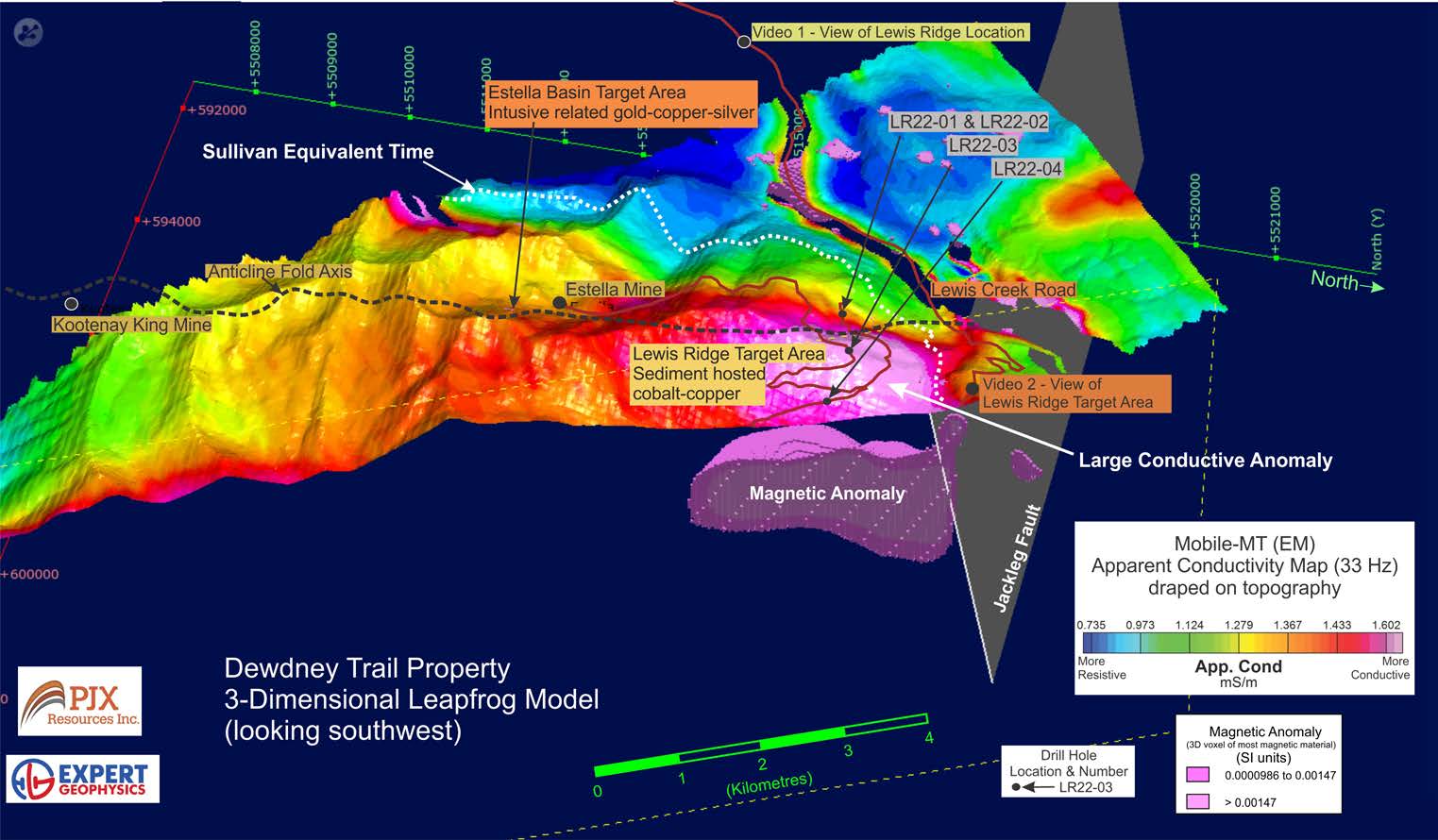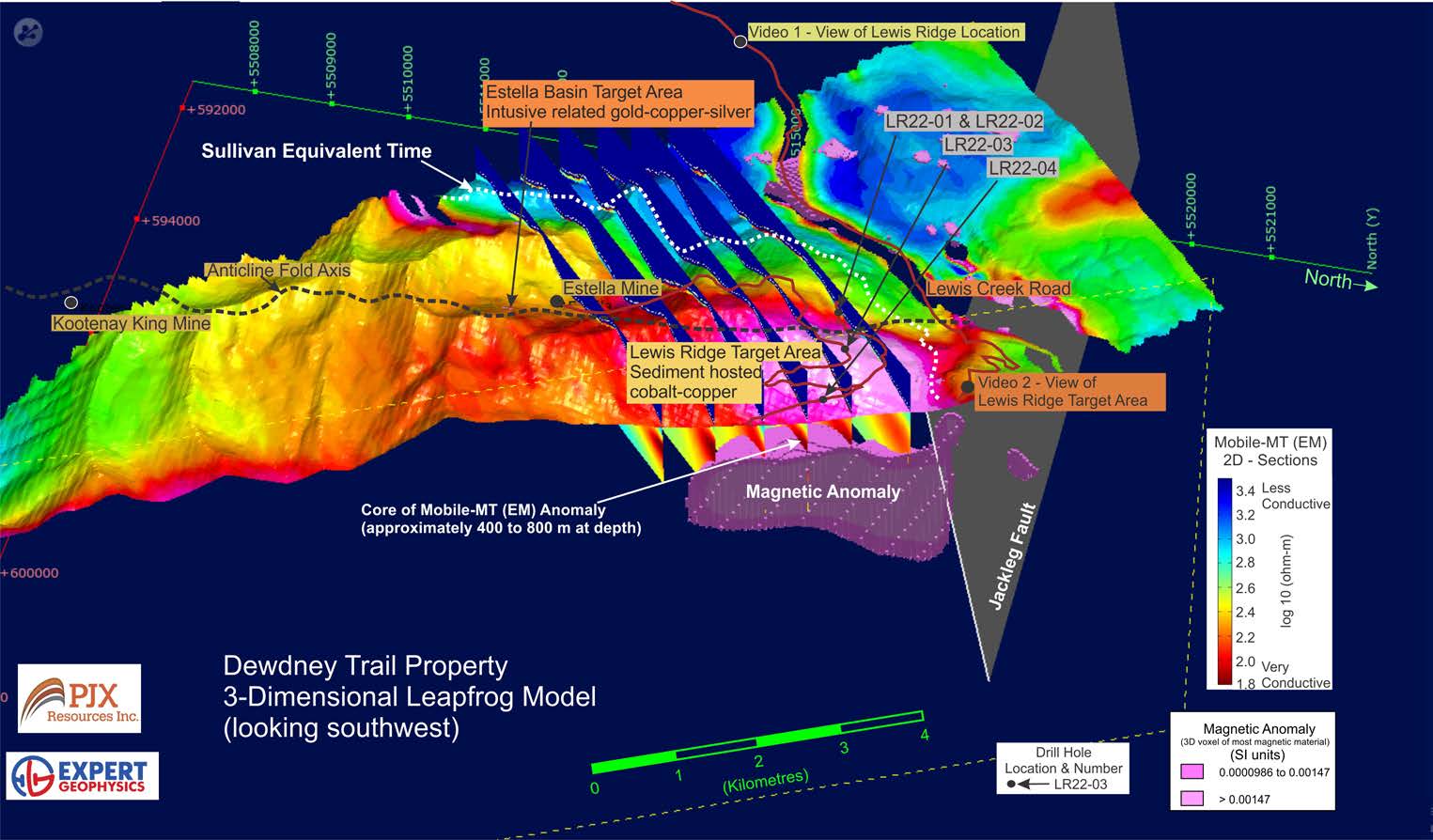par PJX Resources Inc. (isin : CA72585A1093)
PJX Resources Identifies Cobalt-Copper Mineralization Potential in the Sullivan Mining District
TORONTO, ON / ACCESSWIRE / March 30, 2023 / PJX Resources Inc. ("PJX") has intersected massive sulphide with anomalous cobalt (Co), copper (Cu), nickel (Ni) and silver (Ag) in a quartz-dolomite gangue in metasediments that is possibly similar in style to mineralization at the Black Butte copper-cobalt deposit located to the south in Montana (see Photo-A, & Fig. 1).
Mineralization was intersected while drilling Mobile-MT electromagnetic (EM) and magnetic geophysical anomalies at the Lewis Ridge target late last year on the Dewdney Trail Property. The mineralization occurs approximately 3 kilometres north of alkalic intrusive related gold-copper-silver mineralization at PJX'S previously announced Estella Basin target in the Sullivan Mining District and Vulcan Gold Belt of southeastern British Columbia, Canada.
John Keating, President of PJX commented: "This was the first phase of drilling to test EM and magnetic anomalies at the more than 2.5 km long and 1.5 km wide Lewis Ridge target area. Our initial thinking was that geophysics identified potential Sullivan-type zinc-lead-silver mineralization. However, drilling has discovered potential for sediment hosted copper-cobalt type deposits possibly similar to those that occur east of Butte, Montana. PJX plans to further explore and drill the Lewis Ridge copper-cobalt target area, and the previously announced new Estella Basin intrusive-related gold-copper-silver target area this year."

Background
Geology
- Four holes (LR22-01 to LR22-04) were drilled late last year at the Lewis Ridge target to test EM and magnetic anomalies defined by an airborne Mobile-MT (EM) and Magnetic survey flown for PJX by Expert Geophysics.
- Hole LR22-02 intersected massive sulphide mineralization consisting of fine to coarse grained pyrite that has a somewhat net-textured appearance and is fractured or brecciated possibly due to folding (see Photo A above).
- The 1.42 m wide (drill width) zone with 60% massive sulphide in quartz-dolomite gangue was intersected from 125.87m to 127.29 m down hole, and analyzed 644 ppm (0.06%) Co, 819 ppm (0.08%) Cu, 144 ppm Ni and 2.66 ppm (2.6 g/t) Ag.
- The sulphide zone appears bedding parallel and possibly stratabound similar to Black Butte massive pyrite mineralization containing Co, Cu, with anomalous Ni and Ag.
- Black Butte massive pyrite locally contains tennantite (arsenic mineral); Lewis Ridge massive sulphide has 1187 ppm arsenic.
- Black Butte occurs with black shales that are correlative with the middle Aldridge geological formation. Lewis Ridge target occurs at the base of locally black graphitic and/or calcareous silts and argillites of the middle Aldridge.
- Black Butte occurs in the Helena Embayment, a shallow water environment on the east side of the Belt-Purcell rift basin and east of the Butte intrusive related Cu-Molybdenum-Ag deposits. The Lewis Ridge target area is a shallow water environment on the east side of the Belt-Purcell basin, and east of the Sullivan sediment hosted Zn-Pb-Ag deposit (see Fig. 1).
- Black Butte mineralization is associated with an east-west fault called Volcano Valley. The east-west Kimberley Fault influenced the formation of the Sullivan Deposit. The Jackleg fault at Lewis Ridge may be the eastern extension of the Kimberley fault (see Fig 2) Volcano Valley, Kimberley and Jackleg are all considered to be transverse faults in the Belt-Purcell basin.
- Lewis Ridge Target occurs along a large north-south oriented west dipping overturned anticline, and at the equivalent geological time to the Sullivan deposit located about 25 km to the west (see Fig. 3).
Geophysics - Drilling
- The Lewis Ridge zone with massive pyrite, and the overlying locally graphitic and/or calcareous sedimentary rocks are both conductive rock units. Their conductive nature help explain the large EM apparent conductivity geophysical anomaly. However, the 2 units, along with mafic sills intersected, are not magnetic and do not appear to account for magnetic anomalies (see Fig. 4).
- Cu-Co deposits also occur in Idaho. Pyrite is known to replace pyrrhotite in some of these deposits. Pyrrhotite is often magnetic. If the same type of replacement occurs at Lewis Ridge, then any pyrrhotite not replaced by pyrite may generate a magnetic anomaly.
- Hole LR22-01, drilled toward the northeast (Az 047, dip -75), intersected locally graphitic and calcareous sediments above the quartz-carbonate zone from 111.67-116.12 m. The 4.45m (drill width) zone contained minor sulphide veins and a weighted average analysis of 2410 ppm Cu with low Co, Ni, and Ag.
- Hole LR22-02, was drilled toward the southwest (Az 227, dip -80) from the same drill pad as LR22-01.
- Hole LR22-03, was also drilled toward the southwest (Az 227, dip -45) and encountered what appear to be west dipping faults and was abandoned when the hole was becoming stuck in a fault zone.
- Hole LR22-04, was drilled toward the northeast (Az 047, dip -80) to drill across the west dipping faults and test the large EM and somewhat coincident magnetic anomaly at depth (see Fig. 4 and 5). The 800 m hole drilled along the eastern limb of the overturned anticline fold and across a series of faults. This resulted in the hole remaining within the locally graphitic and/or calcareous sediment unit, and therefore did not test the potential horizon with cobalt and copper mineralization at depth that is stratigraphically lower.





Summary
The large magnetic anomaly at depth occurs along the east limb of a broad anticline fold. Folding can cause massive sulphide mineralization to form cigar or irregular shaped deposits. The large magnetic anomaly at depth is somewhat coincident with a large conductive area. This target at depth and other shallow target areas on Lewis Ridge may host multiple cigar shaped and possibly horizontal Cu-Co mineralized bodies (see Fig. 5). The next phase of exploration includes drilling to test shallow targets and the large target area at depth.
Qualified Persons
The foregoing geological disclosure has been reviewed and approved by Dr. Trygve Hoy P.Eng. and John Keating P.Geo. (qualified persons for the purpose of National Instrument 43-101 Standards of Disclosure for Mineral Projects). Dr. Hoy is a Director of PJX, and Mr. Keating is the President, Chief Executive Officer and a Director of PJX.
About PJX Resources Inc.
PJX is a mineral exploration company focused on building shareholder value and community opportunity through the exploration and development of mineral resources with a focus on gold, silver and base metals (copper, cobalt, lead zinc, and other metals). PJX's primary properties are located in the historical Sullivan Mine District and Vulcan Gold Belt near Cranbrook and Kimberley, British Columbia.
Please refer to our web site http://www.pjxresources.com for additional information.
FOR ADDITIONAL INFORMATION PLEASE CONTACT:
Linda Brennan, Chief Financial Officer
(416) 799-9205
info@pjxresources.com
Cautionary Note Regarding Forward-Looking Information
The information in this news release has been prepared as at the date noted above. Certain statements in this news release, referred to herein as "forward-looking statements", constitute "forward-looking statements" under the provisions of Canadian provincial securities laws. These statements can be identified by the use of words such as "expected", "may", "will" or similar terms.
Forward-looking statements are necessarily based upon a number of factors and assumptions that, while considered reasonable by PJX Resources Inc. as of the date of such statements, are inherently subject to significant business, economic and competitive uncertainties and contingencies. Many factors, known and unknown, could cause actual results to be materially different from those expressed or implied by such forward-looking statements. Readers are cautioned not to place undue reliance on these forward-looking statements, which speak only as of the date made. Except as otherwise required by law, PJX Resources Inc. expressly disclaims any obligation or undertaking to release publicly any updates or revisions to any such statements to reflect any change in PJX Resources Inc.'s expectations or any change in events, conditions or circumstances on which any such statement is based.
Cautionary Note to US Investors:
This news release may contain information about adjacent properties on which PJX Resources Inc. has no right to explore or mine. We advise U.S. investors that the SEC's mining guidelines strictly prohibit information of this type in documents filed with the SEC. U.S. investors are cautioned that mineral deposits on adjacent properties are not indicative of mineral deposits on our properties. This news release may contain forward-looking statements including but not limited to comments regarding the timing and content of upcoming work programs, geological interpretations, receipt of property titles, potential mineral recovery processes, etc. Forward-looking statements address future events and conditions and therefore involve inherent risks and uncertainties. Actual results may differ materially from those currently anticipated in such statements.
This press release uses the terms "Measured", "Indicated", and "Inferred" resources. United States investors are advised that while such terms are recognized and required by Canadian regulations, the United States Securities and Exchange Commission does not recognize them. "Inferred Mineral Resources" have a great amount of uncertainty as to their existence, and as to their economic and legal feasibility. It cannot be assumed that all or any part of an Inferred Mineral Resource will ever be upgraded to a higher category. Under Canadian rules, estimates of Inferred Mineral Resources may not form the basis of feasibility or other economic studies. United States investors are cautioned not to assume that all or any part of Measured or Indicated Mineral Resources will ever be converted into Mineral Reserves. United States investors are also cautioned not to assume that all or any part of a Mineral Resource is economically or legally mineable.
Neither the TSX Venture Exchange nor its Regulation Services Provider (as that term is defined in the policies of the TSX Venture Exchange) accepts responsibility for the adequacy or accuracy of this release.
SOURCE: PJX Resources Inc.
View source version on accesswire.com:
https://www.accesswire.com/746529/PJX-Resources-Identifies-Cobalt-Copper-Mineralization-Potential-in-the-Sullivan-Mining-District

